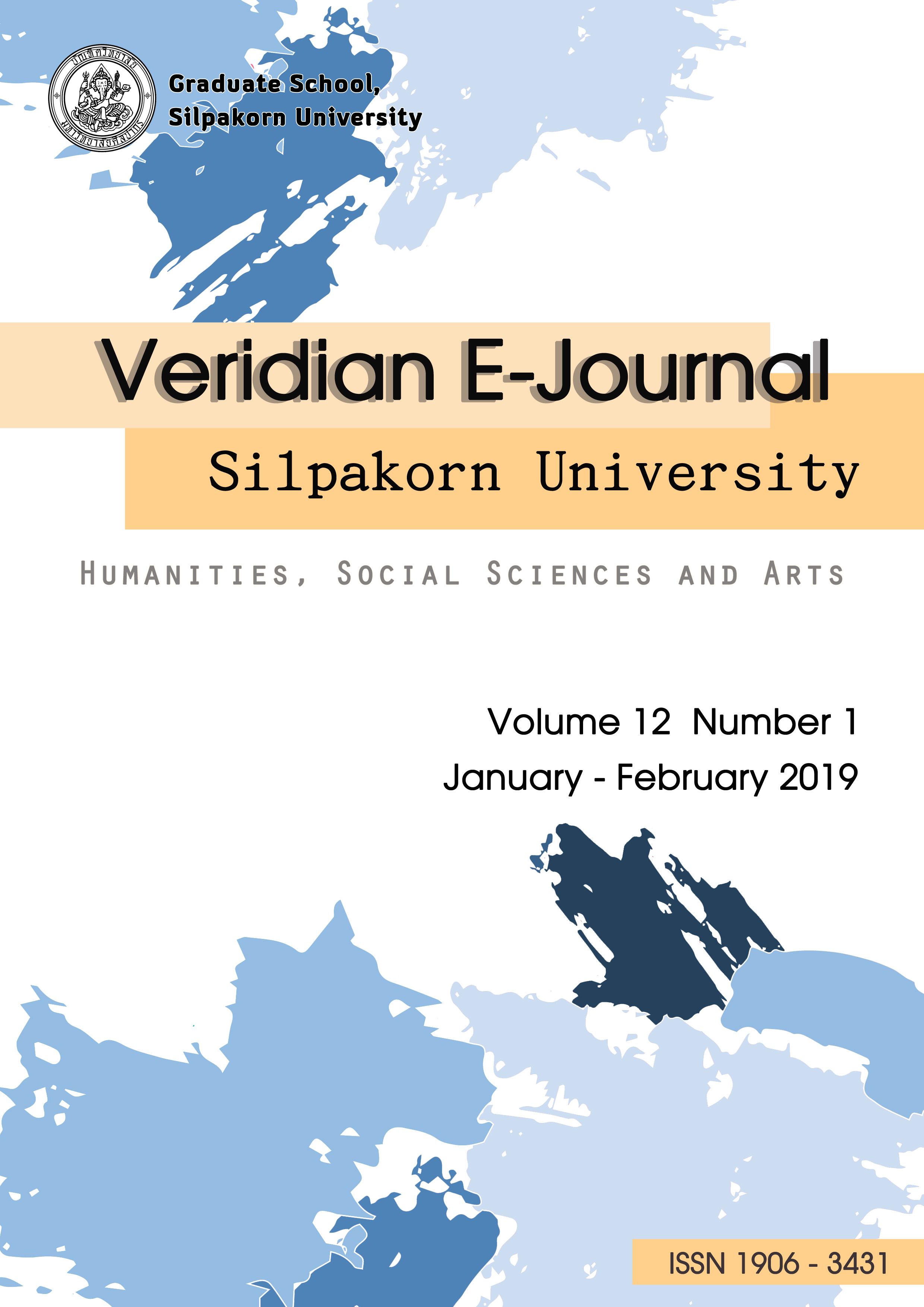การใช้กิจกรรมสถานการณ์จำลองเพื่อส่งเสริมความสามารถในการฟังและการพูดภาษาจีน ของนักเรียนชั้นประถมศึกษาปีที่ 5 (Using Simulation Activities to Promote the Chinese Listening and Speaking Abilities of Grade 5 Students)
Main Article Content
บทคัดย่อ
การวิจัยเรื่อง การใช้กิจกรรมสถานการณ์จำลองเพื่อส่งเสริมความสามารถในการฟังและการพูดภาษาจีนของนักเรียนชั้นประถมศึกษาปีที่ 5 โรงเรียนพระหฤทัยเชียงใหม่ มีวัตถุประสงค์เพื่อ 1) ศึกษาความสามารถทางการฟังและการพูดภาษาจีนของนักเรียนหลังการเรียนโดยใช้กิจกรรมสถานการณ์จำลอง และ 2) ศึกษาความพึงพอใจของนักเรียนที่มีต่อการจัดกิจกรรมสถานการณ์จำลอง กลุ่มตัวอย่างที่ใช้ในการศึกษา คือ นักเรียนชั้นประถมศึกษาปีที่ 5/4 จำนวน 25 คน โรงเรียนพระหฤทัยเชียงใหม่ จังหวัดเชียงใหม่ ได้มาโดยการสุ่มแบบกลุ่ม (Cluster random sampling) เครื่องมือที่ใช้ในการวิจัยประกอบด้วย แผนการจัดการเรียนรู้โดยใช้กิจกรรมสถานการณ์จำลองเพื่อเสริมสร้างความสามารถในการฟังและการพูดภาษาจีน จำนวน 8 แผน แบบประเมินความสามารถในการฟัง แบบประเมินความสามารถในการพูดภาษาจีน และแบบสอบถามความพึงพอใจต่อการใช้กิจกรรมสถานการณ์จำลอง วิเคราะห์โดยการหาค่าร้อยละ ค่าเฉลี่ย ส่วนเบี่ยงเบนมาตรฐาน และค่าสถิติทดสอบที
ผลการศึกษา พบว่า 1) ความสามารถในการฟังภาษาจีนของนักเรียนหลังการเรียนโดยใช้กิจกรรมสถานการณ์จำลองอยู่ในระดับดีมาก และความสามารถทางการพูดภาษาจีนของนักเรียนหลังการเรียนโดยใช้กิจกรรมสถานการณ์จำลองอยู่ในระดับดีมาก และสูงกว่าเกณฑ์ 70% อย่างมีนัยสำคัญทางสถิติที่ระดับ .01 และ 2) ความพึงพอใจของนักเรียนที่มีต่อกิจกรรมสถานการณ์จำลองอยู่ในระดับมากที่สุด
The purposes of this study were 1) to study the students’ Chinese listening and speaking abilities after using simulation activities comparing with the setting criterion (at 70% and above) to study the satisfaction of the students' after being taught through learning simulation activities. The sample were 25 grade 5 students in 5/4 classroom of Sacred Heart College chosen by cluster random sampling. Research tools consisted of eight lesson plans which used simulation activities to promote the Chinese listening and speaking abilities, Chinese listening and speaking evaluation forms, and satisfaction evaluation form of simulation activities. Quantitative data were analyzed by percentages, means, standard deviations, t-test.
The results of this study were as followed: 1) The students’ abilities in Chinese listening and speaking were at very good level and significantly higher than the setting criterion at the .01 level, and 2) The students' satisfaction towards simulation activities was at the highest level.Keywords: Simulation Activities, Listening and Speaking Chinese language
Article Details
เอกสารอ้างอิง
2) Glover, J. A. (2002). Cognitive psychology for Teachers. New York: Mcmillan.
3) Intasingh, S. (2011). “Evaluation of Mathematics Curriculum in the Upper Secondary School Levelat The Prince Royal’s College, Chiang Mai Province”. Veridian E-Journal, Silpakorn
University, Thai Version, Humanities, Social Sciences and Arts Issue, 4,2 (September – December) : 229-247.
4) Intasingh, S. (2016). “Alternative Education: Differentiated Curriculum and Instruction”. Veridian E-Journal, Silpakorn University, Thai Version, Humanities, Social Sciences and Arts Issue, 9,2 (May – August) : 1188 -1106.
5) Interscholarship. World's Top Languages. [online] on 5 July 2017 from https://th.interscholarship.com/tonsung/1440.
6) Jamoosri, P. (2013). Use of simulation activities to promote Thai listening and speaking abilities and understanding of Thai Culture Among Lanna International school students. Master of Education Thesis, Graduate school, Chiang Mai University.
7) Joyce and Weil. (2004). Models of teaching. London: Prentice Hall.
8) Leekitchwatana, P. (2015). Research Method in Education. (10 ed.). Bangkok: MEAN service supply
9) Masuntisuk, R. (2007). Chinese Language Teaching in Thailand at the Primary and Secondary Education Levels. Chinese Studies Center, Institute of Asian Studies, Chulalongkorn University.
10) Ministry of Education. (2008). The Basic Education Core Curriculum B.E. 2551 (A.D. 2008). Bangkok : Printing Agricultural Cooperative Federation of Thailand.
11) Nounlong, T. (2015). The Scenarios and Problems of English Learning and Teaching for Prathomsuksa 4-6 in Dararajchawit School Group under the Uttaradit Primary Educational Service Area Office 1. Report on National and International Research Symposium (Proceedings) Graduate Network North 15th Rajabhat University.
12) Phuong, A. (2007). Use of simulation activities to promote English listening speaking abilities and motivation of developing level students. Master of Education Thesis Graduate, Chiang Mai University.
13) Prombungram, K. (2008). Use of simulation activities in business English course of vocational education certificate students, Chiang Mai Vocational College.
Master of Education Thesis, Graduate school, Chiang Mai University.
14) Razali, N.F. and Ismail, R. (2017). The use of Simulation and Role-Play in Enhancing Speaking Skills in Learning English Language. Journal of Education and Social Sciences, 6(2), 72-78.
15) Thabseerak, K. (2016). The development of reading with a game and learning activities of chinese language for grade 1 Student. Reported by National Education Conference the 1st, Faculty of Education, Kalasin University.
16) Wiriyachitra, A. (1989). Teaching Language for Communication. Bangkok: Aksornjaroantat.

